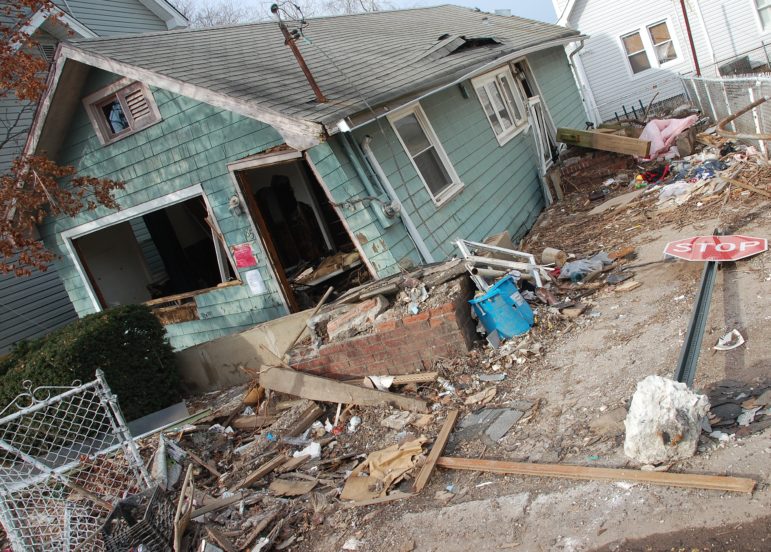
Thomas Good
Damage from Hurricane Sandy in Staten Island.
As global climate change makes powerful storms more likely, it is more important than ever that communities are prepared for natural disasters. After years of experience working with families in the wake of Superstorm Sandy, we have learned that successful disaster recovery depends on non-profit legal and housing assistance.
A new report on the City’s Hurricane Sandy recovery program, Build It Back, bolsters this idea.
Researchers at the City University of New York’s Center for Urban Research (CUNY CUR) found that free, high-quality legal and financial counseling, which the Center for NYC Neighborhoods oversaw, was a key factor in helping to retain participants in Build It Back who otherwise would not have completed the difficult recovery and reconstruction process.
This finding may be surprising to some, but for households who have been affected by a disaster and have faced down the myriad challenges of recovery, it may not be. Having a non-profit lawyer or housing advocate on your side as you navigate insurance, mortgage relief, and complex federal and local regulations impeding your recovery can make all the difference, especially for households without significant financial resources.
We’re proud of our work helping families from the beginning of reconstruction all the way through moving back into their homes. Under the leadership of the Mayor’s Office of Housing Recovery Operations, the Center managed Build It Back’s counseling program through a network of over 40 professionals at partner organizations, such as New York Legal Assistance Group and Neighborhood Housing Services of Brooklyn. The program has helped over 5,000 homeowners navigate a complex disaster recovery process, helping New Yorkers rebuild their lives and homes.
They are seniors like 69-year-old Nancy O., whose home in Queens was severely damaged by Hurricane Sandy: Exterior walls had been stripped from the first floor, hot water and heat had been knocked out, and the home’s foundation was rendered unstable. Around November 2015, Build It Back program engineers had to issue a notice to vacate the premises after it was determined that the structure represented a life hazard to the family. Nancy needed more than just construction assistance; after being financially drained by her recovery from the storm, she and her family were on the verge of homelessness and needed to reclaim her financial well-being in order to fully recover from Sandy.
At the time, Nancy had a gross monthly income of $4,800, which included Social Security benefits and earnings from her employment as a dressmaker. When she began working with our counseling program, her primary goal was to qualify for enough federal assistance by showing she still had unmet needs despite receiving some prior disaster assistance. Counselors helped her meticulously account for the costs of her recovery and made the case that she should qualify for more assistance. As a result, she was able to secure an additional $25,000 of recovery assistance through Build It Back. To help her avoid homelessness, she was enrolled in Build It Back’s Temporary Housing Services program, managed by the Center, to help her find and pay for her family’s relocation while her home was restored. Ultimately, with the help of the Center and its partners working together with the City, Nancy was able to move back into her fully rebuilt home at the end of 2018.
Pairing disaster recovery with expert counseling to help people like Nancy is an innovative model that other communities should adopt, and makes sense given the challenges families across the country face when recovering from disasters. This is especially true for complex disaster recovery programs that involve federal money, and all the regulations and requirements that filter down to individuals and can ensnare them in a web of headaches. That’s why we believe that non-profit legal and financial counseling should be integrated into all future programs.
Build It Back was not initially designed with housing counseling and legal services as essential components of the program — which may have led to lower retention rates when the program first launched, eight months after Sandy struck the city on Oct. 29, 2012. But after listening to and partnering with communities and non-profit organizations, the de Blasio administration integrated these services into the program and reframed the role of counselors as independent advocates for disaster victims. The CUNY CUR study cites this as an important improvement the City made to the program after a difficult start. Besides working one-on-one with homeowners, counseling Help Desks were co-located at Build It Back centers and community outreach events.
For families, storm recovery is a lengthy, taxing process that requires immense endurance. It is imperative that we work with partners in government and on the ground to avoid the fatigue that can lead to disengagement. This is where non-profit counseling and legal services can play a role — by serving as a recovery safety net in the midst of a highly complex, disruptive personal and financial crisis.
Joseph Sant, William Fairhurst and Rudy Ulin work for the Center for NYC Neighborhoods and have lead the non-profit organization’s housing recovery programs.
Get the best of City Limits news in your inbox.
Select any of our free weekly newsletters and stay informed on the latest policy-focused, independent news.









2 thoughts on “Opinion: Legal and Financial Advice Must Be Part of Every Community’s Disaster Response Kit”
Pingback: This Week in Disaster Resilience 22 February 2019 – molinostewart
Oh I receive a mud and gravel swimming pool basement for my Build it Back. While the person a couple of feet from me receives a total rebuild. They make you take the keys when you do not even have a working stove. Its been a complete nightmare